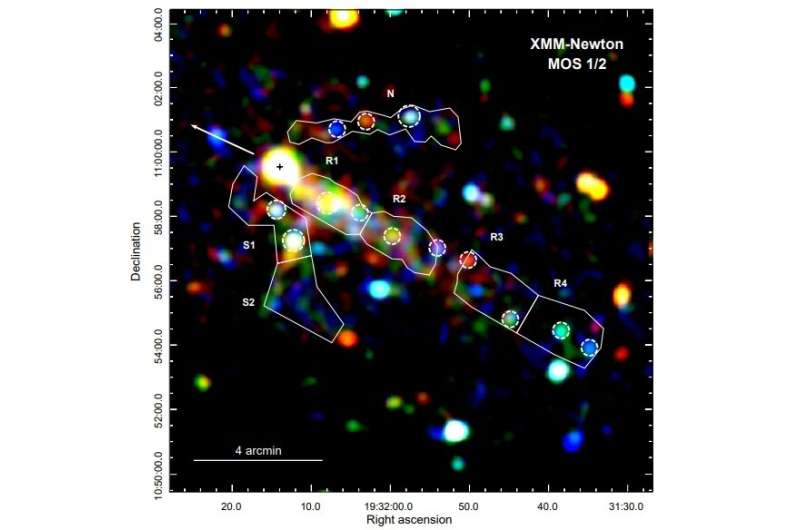May 6, 2020 report
Astronomers probe the emission from a nearby pulsar wind nebula

Astronomers from South Korea and China have performed a deep X-ray spectral imaging of a bow-shock pulsar wind nebula (PWN) associated with a nearby pulsar designated PSR B1929+10. The new study, published April 29 on arXiv.org, presents the deepest investigation of the system, disclosing important information about the emission from this PWN.
PWNe are nebulae powered by the wind of a pulsar. Pulsar wind is composed of charged particles, and when it collides with the pulsar's surroundings, in particular with the slowly expanding supernova ejecta, it develops a PWN. In some cases, when fast-moving pulsars traverse the interstellar medium (ISM) with supersonic speed, a bow-shock PWN may be formed.
At a distance of about 2,057 light years from the sun, PSR B1929+10 is one of the nearest pulsars. It has a spin period of 226.5 milliseconds and a projected velocity of 177 km/s. Observations have shown that it is one of the oldest known pulsars with an X-ray nebula and appears to be one of the brightest mature pulsars associated with a bow-shock PWN.
However, the nature of PSR B1929+10's PWN is still poorly understood. For instance, researchers suppose that this nebula could have several spatial components, and it is unknown whether there is any spectral variation across the extended X-ray feature assumed to be originating from the bow-shock PWN.
In order to resolve the uncertainties, a team of astronomers led by Sangin Kim of Chungnam National University in Daejeon, South Korea, has conducted an X-ray spectral imaging analysis of PSR B1929+10's PWN with an exposure much deeper than in previous studies. Their study is based on the data obtained by ESA's XMM-Newton spacecraft.
"In this work, we study the X-ray bow-shock nebula powered by the mature pulsar PSR B1929+10 using data from XMM-Newton, with an effective exposure of ∼300 ks, offering the deepest investigation of this system thus far," the researchers wrote in the paper.
The researchers detected an X-ray axial outflow behind the proper motion direction, which was reported by previous observations. They found that this outflow has an extent of about eight arcminutes, which is twice the length estimated by previous study published in 2006.
Moreover, the X-ray emission of the axial outflow appears to be getting systematically harder in the opposite direction of the pulsar's proper motion. The astronomers assume that the observed spectral hardening may be explained by certain acceleration processes occurring along this feature. They noted that magnetic energy can be converted into the kinetic energy of wind particles, what can result in very efficient particle acceleration.
Besides the X-ray axial outflow, the study also detected two faint lateral outflows extending laterally with respect to the proper motion. Their orientations turned out to be similar to those observed in some other pulsars with PWNe. The authors of the paper suggest that such features can result from polar outflows which are bent by the ram pressure
More information: A deep X-ray spectral imaging of the bow-shock pulsar wind nebula associated with PSR B1929+10, arXiv:2004.14019 [astro-ph.HE] arxiv.org/abs/2004.14019
© 2020 Science X Network




















